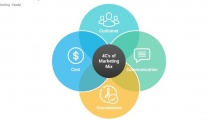I. What is the Eisenhower Matrix?
1. Concepts
The Eisenhower Matrix, or Urgency-Importance Matrix, is a way to organize tasks by urgency and importance, so you can prioritize your most important tasks. yourself effectively.
Usually, the Eisen matrix is constructed by splitting into four angles:
Corner 1: Do it first
Corner 2: Schedule
Corner 3: Authorization
Corner 4: Delete
And to be able to divide tasks into 4 corners, users do it by classifying work into 4 levels:
- Urgent and important (tasks you will do immediately).
- Important, but not urgent (tasks you will schedule to do later).
- Urgent, but not important (tasks you will delegate to someone else).
- Neither urgent nor important (the task that you will eliminate).
2. Why is it called the Eisenhower Matrix?
The easiest thing to understand is that this matrix model was created by Dwight D. Eisenhower – the 34th President of the United States and a five-star general during World War II. In a 1954 speech, Eisenhower quoted an unnamed university president as saying, “I have two kinds of problems, urgent and important. What is urgent is not important, and what is important is never urgent.”
Dwight constantly has to make tough decisions about which of the many tasks he should focus on each day. This eventually led him to invent the world-famous Eisenhower principle, which today helps us prioritize by urgency and importance.
.png)
II. How to use the Eisenhower Matrix for Time Management
1. Structure of the Eisenhower Matrix
An Eisenhower Matrix is built on 4 quadrants. Here, we will learn together the functions and tasks of each specific corner:
- First quadrant: Do
In this corner, you will place tasks that are both urgent and important. When you see a task on your to-do list that has obvious consequences and affects your long-term goals, put it in this quadrant.
Don't question which tasks fall into this quadrant, because these are the tasks that keep you thinking and are likely to cause you the most stress.
- Second quadrant: Schedule
Important tasks but not yet urgent, not yet due deadline will be placed here. Since these tasks affect your long-term goals but don't need to be done right away, you can schedule them later. You will solve these quests immediately after solving the tasks in quadrant one. You can use various time management tips to help you complete the tasks in this quadrant.
- Third quadrant: Authorization
This section includes tasks that must be completed now, but they should not affect your long-term goals. So you can delegate these tasks to other members of your team. Delegating tasks is one of the most effective ways to manage admin workload and gives your team the opportunity to expand their skill set.
- Fourth quadrant: Delete
Unimportant, non-urgent tasks can prevent you from accomplishing your goals. So you need to filter out the unimportant tasks and put them on your to-do list in the fourth quadrant, the “delete” quadrant.
2. 4 tips for prioritizing your tasks
Color grading by level for each task you have to do
During the task listing process, you should also sort the order of tasks by color. You can refer to the color code as follows:
Red = Items with highest priority
Blue = Second highest priority
Green = Third highest priority
Gold = Not a priority
Once you've labeled your tasks by colors, these colors will transfer directly to the Eisenhower Matrix.
Red Task: Your “do” task for quadrant 1.
Blue Task: Your “schedule” task for quadrant two.
Green Task: Your “authorize” task for quadrant three.
Yellow Mission: Your “erase” quest for quadrant four.
Limit the number of specific quests in each category
Try to limit the maximum number of tasks to be done in each quadrant to 5 tasks even if you have a lot of tasks to do. Limiting the number of such tasks will help keep your matrix from being cluttered and overloaded.
Make a to-do list divided by individual and work
Another way to limit the number of items on your Eisenhower Matrix is to create two separate matrices: the personal work matrix and the task to-do matrix.
The problems that need to be solved at work and your personal tasks require different timelines, resources and methods, so the resolution and resolution process in these two aspects will also be different.
Perform removal before optimization
Eliminate unnecessary tasks first to be able to prioritize effectively. With this approach, you'll be in quadrant four first.
In fact, 60% of every person's time at work is spent on things like sharing approval status or tracking information. If you can quickly go through the process of sorting and prioritizing items go ahead and do so. This will speed up the prioritization process and you will likely experience a second round of elimination on the back end.












Replies to This Discussion